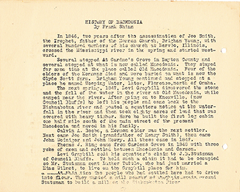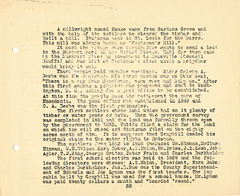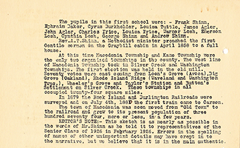| |
1926 Yearbook Home |
|
 |
Macedonia High School Yearbook
Town History
by Frank Shinn
1926

Click photo to enlarge

Click photo to enlarge

Click photo to enlarge
In 1846, two years after the assassination of Joe Smith,
the Prophet, father of the Mormon Church, Brigham Young, with
several hundred members of his church at Narvoo [sic] Illinois,
crossed the Mississipi river in the spring and started west-
ward.
Several stopped at Gardne's [Garden's] Grove in Dayton County and
several stopped at what is now called Macedonia. They stayed
for some time at the place called Old Macedonia. Four of the
elders of the Mormons died and were buried on what is now the
Clyde Scott farm. Brigham Young continued and stopped at a
place he named Weeping Water, later, Florence, north of Omaha.
The next spring, 1847, Levi Graybill discovered the stone
and the fall of the water in the river at Old Macedonia, while
camped near the river. After going on to Knoxville, (now
Council Bluffs) he left his people and came back to the
Nishnabotna river and posted a squatters notice at the water-
fall in the river and then took eighty acres of land that was
covered with heavy timber. Here he built the first log cabin
one half mile south of the main street of the present
Macedonia and moved in his family.
Calvin A. Beebe, a Mormon elder was the next settler.
Next came Joe Smith (grandfather of Henry Smith), then came
John Weiniger and John Mowry. All these came in 1847.
Thomas J. Ring came from Gardens Grove in 1848 with three
yoke of oxen and settled between Macedonia and Carson.
Levi Graybill sold his squatter's claim to J. B. Stutzman
of Council Bluffs. To hold such a claim it had to be occupied
so Mr. Stutzman sent Luther Tuttle, who had just married a
Miss Wilmot, to live on the Graybille place for him.
At this time the peole who had settled here had to drive
a hundred miles south into Missouri to get their grain ground
into flour. They wanted a mill nearer so they persuaded
Stutzman to build a mill on the Nishnabotna River.
A millwright named Hauze came from Gardens Grove and
with the help of the settlers he cleared the timber and
built a mill. Stutzman sent to St. Louis for the burrs.
This mill was always known as "Stutzman's Mill."
It cost the people here twenty-five cents to send a letter
to the Eastern part of the United States. Mail for them came
to the Missouri River by steamboat to Knoxville (Council
Bluffs) and was left at Stutzman's store until a neighbor
would bring it out.
There people held regular meetings. Elder Calvin A.
Beebe was the minister. His first sermon was on this text,
"There is a cry from Macedonia, come over and help us." After
this first sermon a petition was prepared and sent to Wash-
ington, D. C., asking for a post office to be established.
At this time the people gave the settlement the name of
Macedonia. The post office was established in 1849 and
C. A. Beebe was the first postmaster.
The first settlers chose land which had on it plenty of
timber or water power or both. When the government survey
was completed in 1851 and the land was formally thrown open
by the government in 1853, Tuttle filed a claim for the land
on which the mill stood and Stutzman filed on the eighty
acres north of him. It is supposed that Graybill deeded his
original claim to the water rights to Stutzman.
The settlers from 1853 to 1858 included Wm. Hinman, McClure
Hinman, W. W. Wilson, Ezra Baker, A. T. Shinn, Wm. Price, J. Z. Losh, John
Azler, T. J. Ring, George Cotton, Peter Frain and Charles Burkholder.
The first school election was held in 1858 and the fol-
lowing directors were chosen: A. T. Shinn, President, Ezra Baker
and Charles Burkholder. Jas. B. Rue was the County Superintend-
ent of Schools and Joe Lyman was the first teacher. The log
cabin built by Graybill was used for a school house. Mr. Lyman
was paid twenty dollars a month and "boarded 'round."
The pupils in this first school were: - Frank Shinn,
Ephraim Baker, Cyrus Burkholder, Louisa Tuttle, James Agler,
John Agler, Charles Price, Louisa Price, Warner Losh, Emerson
Losh, Cynthia Losh, George Shinn and Andrew Shinn.
Rev. A. T. Shinn, a Methodist minister preached the first
Gentile sermon in the Graybill cabin in April 1858 to a full
house.
At this time Macedonia Township and Kane Township were
the only two organized townships in the county. The west line
of Macedonia Township took in Silver Creek and Washington
Townships. The first election was held in the old mill.
Seventy votes were cast coming from Leon's Grove (Avoca), Big
Grove (Oakland), Rhode Island Ridge (Waveland and Washington
Twps.), Wheeler's Grove and Taylor's Station and Button's
Settlement on Silver Creek. These townships in all
occupied twenty-four square miles.
In 1879 the Rock Island and Burlington Railroads were
surveyed and on July 4th, 1880 the first train came to Carson.
The town of Macedonia was soon moved from "Old Town" to
the railroad and grew to its present population of three
hundred seventy four, more or less, in a few years.
EDITOR'S NOTE: - This sketch is as nearly as possible in
the words of Mr. Shinn as he told it to representatives of the
Senior Class of 1926 in February 1926. Errors in the spelling
of names or other unimportant details may have crept in to
the narrative, but we believe that it is in the main authentic.
|
 |
 |
Contributed by Kimberlee Smith Johnson
|
 |
 |
|
|